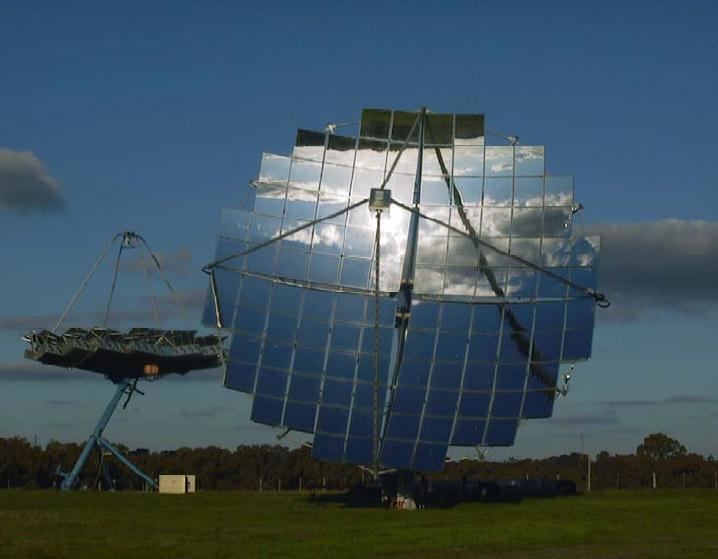 | ||
Concentrator photovoltaics (CPV) (also known as Concentration Photovoltaics) is a photovoltaic technology that generates electricity from sunlight. Contrary to conventional photovoltaic systems, it uses lenses and curved mirrors to focus sunlight onto small, but highly efficient, multi-junction (MJ) solar cells. In addition, CPV systems often use solar trackers and sometimes a cooling system to further increase their efficiency. Ongoing research and development is rapidly improving their competitiveness in the utility-scale segment and in areas of high insolation. This sort of solar technology can be thus used in smaller areas.
Contents
- History
- Challenges
- Efficiency
- Types
- Low concentration PV LCPV
- Medium concentration PV
- High concentration photovoltaics HCPV
- Installations
- List of large CPV systems
- Concentrated photovoltaics and thermal
- Reliability requirements
- Demonstration projects
- References
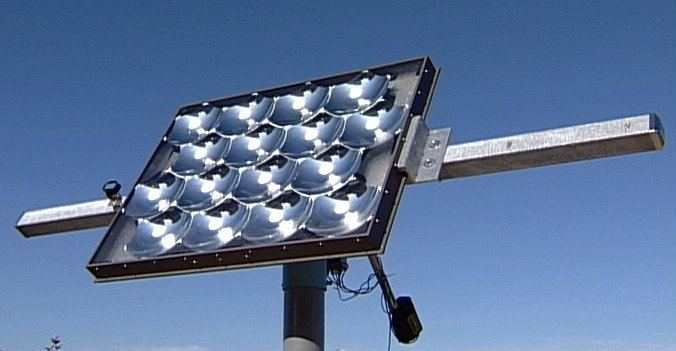
Systems using high-concentration photovoltaics (HCPV) especially have the potential to become competitive in the near future. They possess the highest efficiency of all existing PV technologies, and a smaller photovoltaic array also reduces the balance of system costs. Currently, CPV is not used in the PV rooftop segment and is far less common than conventional PV systems. For regions with a high annual direct normal irradiance of 2000 kilowatt-hour (kWh) per square meter or more, the levelized cost of electricity is in the range of $0.08–$0.15 per kWh and installation cost for a 10-megawatt CPV power plant was identified to lie between €1.40–€2.20 (~$1.50-$2.30) per watt-peak (Wp).
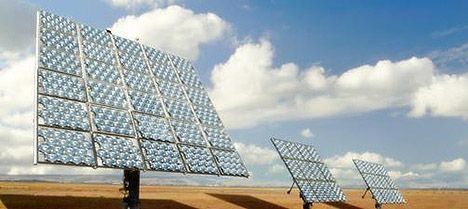
In 2016, cumulative CPV installations reached 350 megawatts (MW), less than 0.2% of the global installed capacity of 230,000 MW. Commercial HCPV systems reached instantaneous ("spot") efficiencies of up to 42% under standard test conditions (with concentration levels above 400) and the International Energy Agency sees potential to increase the efficiency of this technology to 50% by the mid-2020s. As of December 2014, the best lab cell efficiency for concentrator MJ-cells reached 46% (four or more junctions). Under outdoor, operating conditions, CPV module efficiencies have exceeded 33% ("one third of a sun"). System-level AC efficiencies are in the range of 25-28%. CPV installations are located in China, the United States, South Africa, Italy and Spain.
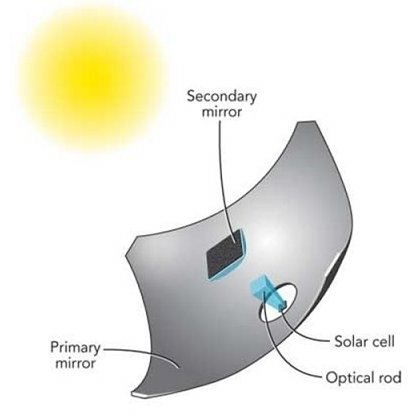
HCPV directly competes with concentrated solar power (CSP) as both technologies are suited best for areas with high direct normal irradiance, which are also known as the Sun Belt region in the United States and the Golden Banana in Southern Europe. CPV and CSP are often confused with one another, despite being intrinsically different technologies from the start: CPV uses the photovoltaic effect to directly generate electricity from sunlight, while CSP – often called concentrated solar thermal – uses the heat from the sun's radiation in order to make steam to drive a turbine, that then produces electricity using a generator. Currently, CSP is more common than CPV.
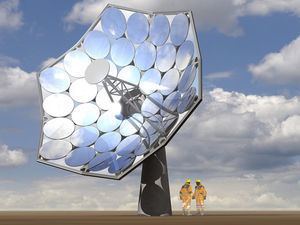
History
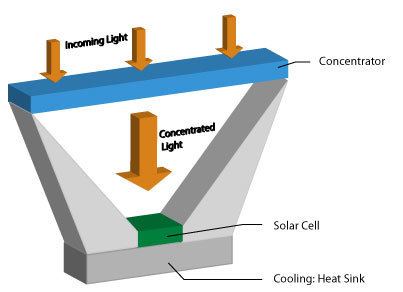
Research into concentrator photovoltaics has taken place since the mid 1970s, initially spurred on by the energy shock from a mideast oil embargo. Sandia National Laboratories in Albuquerque, New Mexico was the site for most of the early work, with the first modern-like photovoltaic concentrating system produced there late in the decade. Their first system was a linear-trough concentrator system that used a point focus acrylic Fresnel lens focusing on water-cooled silicon cells and two axis tracking. Cell cooling with a passive heat sink was demonstrated in 1979 by Ramón Areces. The 350kW SOLERAS project in Saudi Arabia - the largest until many years later - was constructed by Sandia/Martin Marietta in 1981.

Research and development without significant industry interest continued through the 1980's and 1990's. Improvements in cell efficiency were soon recognized as essential to making the technology economical. However the improvements to Si-based cell technology used by both concentrators and flat PV failed to clearly favor the system-level economics of CPV. R&D into III-V Multi-junction solar cells starting in the early 2000's has since provided a clear differentiator for CPV. MTJ cell efficiencies have since improved from 34% (3-junctions) to 46% (4-junctions) at research-scale production levels. A substantial number of multi-MW modern CPV projects have been commissioned worldwide starting in 2010, and ongoing evaluations should build further confidence in the technology.
Challenges
Modern CPV systems operate most efficiently in highly concentrated sunlight (i.e. concentration levels equivalent to hundreds of suns), as long as the solar cell is kept cool through the use of heat sinks. Diffuse light, which occurs in cloudy and overcast conditions, cannot be highly concentrated using conventional optical components only (i.e. macroscopic lenses and mirrors). Filtered light, which occurs in hazy or polluted conditions, has spectral variations which produce mismatches between the electrical currents generated within the series-connected junctions of spectrally "tuned" multi-junction (MJ) photovoltaic cells. These CPV features lead to rapid decreases in power output when atmospheric conditions are less than ideal.
To produce equal or greater energy per rated watt than conventional PV systems, CPV systems must be located in areas that receive plentiful direct sunlight. This is typically specified as average DNI greater than 5.5-6 kWh/m2/day or 2000kWh/m2/yr. Otherwise, evaluations of annualized DNI vs. GNI/GHI irradiance data have concluded that conventional PV should still perform better over time than presently available CPV technology in most regions of the world (see for example ).
The design of macroscopic sunlight concentrators for CPV introduces a very specific optical design problem, with features that makes it different from any other optical design. It has to be efficient, suitable for mass production, capable of high concentration, insensitive to manufacturing and mounting inaccuracies, and capable of providing uniform illumination of the cell. All these reasons make nonimaging optics the most suitable for CPV.
In late 2015, ARPA-E announced a first round of R&D funding for the MOSAIC Program (Microscale Optimized Solar-cell Arrays with Integrated Concentration) to further combat the location and expense challenges of existing CPV technology. As stated in the program description: "MOSAIC projects are grouped into three categories: complete systems that cost effectively integrate micro-CPV for regions such as sunny areas of the U.S. southwest that have high Direct Normal Incident (DNI) solar radiation; complete systems that apply to regions, such as areas of the U.S. Northeast and Midwest, that have low DNI solar radiation or high diffuse solar radiation; and concepts that seek partial solutions to technology challenges."
Efficiency
All CPV systems have a concentrating optic and a solar cell. Generally, active solar tracking is necessary. Low-concentration systems often have a simple booster reflector, which can increase solar electric output by over 30% from that of non-concentrator PV systems. Experimental results from such LCPV systems in Canada resulted in energy gains over 40% for prismatic glass and 45% for traditional crystalline silicon PV modules.
Semiconductor properties allow solar cells to operate more efficiently in concentrated light, as long as the cell Junction temperature is kept cool by suitable heat sinks. Efficiency of multi-junction photovoltaic cells developed in research is upward of 44% today, with the potential to approach 50% in the coming years.
Also crucial to the efficiency (and cost) of a CPV system is the concentrating optic since it collects and concentrates sunlight onto the solar cell. For a given concentration, nonimaging optics combine the widest possible acceptance angles with high efficiency and, therefore, are the most appropriate for use in solar concentration. For very low concentrations, the wide acceptance angles of nonimaging optics avoid the need for active solar tracking. For medium and high concentrations, a wide acceptance angle can be seen as a measure of how tolerant the optic is to imperfections in the whole system. It is vital to start with a wide acceptance angle since it must be able to accommodate tracking errors, movements of the system due to wind, imperfectly manufactured optics, imperfectly assembled components, finite stiffness of the supporting structure or its deformation due to aging, among other factors. All of these reduce the initial acceptance angle and, after they are all factored in, the system must still be able to capture the finite angular aperture of sunlight.
Types
CPV systems are categorized according to the amount of their solar concentration, measured in "suns" (the square of the magnification).
Low concentration PV (LCPV)
Low concentration PV are systems with a solar concentration of 2–100 suns. For economic reasons, conventional or modified silicon solar cells are typically used, and, at these concentrations, the heat flux is low enough that the cells do not need to be actively cooled. There is now modeling and experimental evidence that standard solar modules do not need any modification, tracking or cooling if the concentration level is low and yet still have increased output of 35% or more. The laws of optics dictate that a solar collector with a low concentration ratio can have a high acceptance angle and thus in some instances does not require active solar tracking.
Medium concentration PV
From concentrations of 100 to 300 suns, the CPV systems require two-axes solar tracking and cooling (whether passive or active), which makes them more complex.
High concentration photovoltaics (HCPV)
High concentration photovoltaics (HCPV) systems employ concentrating optics consisting of dish reflectors or fresnel lenses that concentrate sunlight to intensities of 1,000 suns or more. The solar cells require high-capacity heat sinks to prevent thermal destruction and to manage temperature related electrical performance and life expectancy losses. To further exacerbate the concentrated cooling design, the heat sink must be passive, otherwise the power required for active cooling will reduce the overall conversion efficiency and economy. Multi-junction solar cells are currently favored over single junction cells, as they are more efficient and have a lower temperature coefficient (less loss in efficiency with an increase in temperature). The efficiency of both cell types rises with increased concentration; multi-junction efficiency rises faster. Multi-junction solar cells, originally designed for non-concentrating PV on space-based satellites, have been re-designed due to the high-current density encountered with CPV (typically 8 A/cm2 at 500 suns). Though the cost of multi-junction solar cells is roughly 100 times that of conventional silicon cells of the same area, the small cell area employed makes the relative costs of cells in each system comparable and the system economics favor the multi-junction cells. Multi-junction cell efficiency has now reached 44% in production cells.
The 44% value given above is for a specific set of conditions known as "standard test conditions". These include a specific spectrum, an incident optical power of 850 W/m², and a cell temperature of 25 °C. In a concentrating system, the cell will typically operate under conditions of variable spectrum, lower optical power, and higher temperature. The optics needed to concentrate the light have limited efficiency themselves, in the range of 75–90%. Taking these factors into account, a solar module incorporating a 44% multi-junction cell might deliver a DC efficiency around 36%. Under similar conditions, a crystalline silicon module would deliver an efficiency of less than 18%.
When high concentration is needed (500–1000 times), as occurs in the case of high efficiency multi-junction solar cells, it is likely that it will be crucial for commercial success at the system level to achieve such concentration with a sufficient acceptance angle. This allows tolerance in mass production of all components, relaxes the module assembling and system installation, and decreasing the cost of structural elements. Since the main goal of CPV is to make solar energy inexpensive, there can be used only a few surfaces. Decreasing the number of elements and achieving high acceptance angle, can be relaxed optical and mechanical requirements, such as accuracy of the optical surfaces profiles, the module assembling, the installation, the supporting structure, etc. To this end, improvements in sunshape modelling at the system design stage may lead to higher system efficiencies.
Installations
Concentrator photovoltaics technology has established its presence in the solar industry over the last several years. The first CPV power plant that exceeded 1 MW-level was commissioned in Spain in 2006. By the end of 2015, the number of CPV power plants around the world accounted for a total installed capacity of 350 MW. Field data collected over the past six years is also starting to benchmark the prospects for long-term system reliability.
The emerging CPV segment has comprised ~0.1% of the fast-growing utility market for PV installations over the past decade. Unfortunately, by the end of 2015, the near term outlook for CPV industry growth has faded with closure of all of the largest CPV manufacturing facilities: including those of Suncore, Soitec, Amonix, and Solfocus. Nevertheless, the growth outlook for the overall PV industry continues to appear strong.
List of large CPV systems
The largest CPV power plant currently in operation is of 80 MWp capacity located in Golmud, China, hosted by Suncore Photovoltaics.
Concentrated photovoltaics and thermal
Concentrator photovoltaics and thermal (CPVT), also sometimes called combined heat and power solar (CHAPS) or hybrid thermal CPV, is a cogeneration or micro cogeneration technology used in the field of concentrator photovoltaics that produces usable heat and electricity within the same system. CPVT at high concentrations of over 100 suns (HCPVT) utilizes similar components as HCPV, including dual-axis tracking and multi-junction photovoltaic cells. A fluid actively cools the integrated thermal–photovoltaic receiver, and simultaneously transports the collected heat.
Typically, one or more receivers and a heat exchanger operate within a closed thermal loop. To maintain efficient overall operation and avoid damage from thermal runaway, the demand for heat from the secondary side of the exchanger must be consistently high. Under such optimal operating conditions, collection efficiencies exceeding 70% (up to ~35% electric, ~40% thermal for HCPVT) are anticipated. Net operating efficiencies may be substantially lower depending on how well a system is engineered to match the demands of the particular thermal application.
The maximum temperature of CPVT systems is typically too low alone to power a boiler for additional steam-based cogeneration of electricity. Such systems may be economical to power lower temperature applications having a constant high heat demand. The heat may be employed in district heating, water heating and air conditioning, desalination or process heat. For applications having lower or intermittent heat demand, a system may be augmented with a switchable heat dump to the external environment in order to maintain reliable electrical output and safeguard cell life, despite the resulting reduction in net operating efficiency.
HCPVT active cooling enables the use of much higher power thermal–photovoltaic receiver units, generating typically 1–100 kilowatts electric, as compared to HCPV systems that mostly rely upon passive cooling of single ~20W cells. Such high-power receivers utilize dense arrays of cells mounted on a high-efficiency heat sink. Minimizing the number of individual receiver units is a simplification that should ultimately yield improvement in the overall balance of system costs, manufacturability, maintainability/upgradeability, and reliability.
Reliability requirements
The maximum operating temperatures (Tmax cell) of CPVT systems are limited to less than approximately 100–125 °C on account of the intrinsic reliability limitation of their multi-junction PV cells. This contrasts to CSP and other CHP systems which may be designed to function at temperatures in excess of several hundred degrees. More specifically, the multi-junction photovoltaic cells are fabricated from a layering of thin-film III-V semiconductor materials having intrinsic lifetimes during CPV operation that rapidly decrease with an Arrhenius-type temperature dependence. The system receiver must therefore provide for highly efficient and uniform cell cooling, where an ideal receiver would provide Tmax coolant ~ Tmax cell. In addition to material and design limitations in receiver heat-transfer performance, numerous extrinsic factors, such as the frequent system thermal cycling, further reduce the practical Tmax coolant compatible with long system life to below about 80 °C.
The higher capital costs, lesser standardization, and added engineering & operational complexities (in comparison to zero and low-concentration PV technologies) make demonstrations of system reliability and long-life performance critical challenges for the first generation of CPV and CPVT technologies. Performance certification testing standards (e.g. IEC 62108, UL 8703, IEC 62789, IEC 62670) include stress conditions that may be useful to uncover some predominantly infant and early life (<1–2 year) failure modes at the system, module, and sub-component levels. However, such standardized tests – as typically performed on only a small sampling of units – are generally incapable to evaluate comprehensive long-term (10 to 25 or more years) lifetimes for each unique CPVT system design and application under its broader range of actual operating conditions. Long-life performance of these complex systems is therefore assessed in the field, and is improved through aggressive product development cycles which are guided by the results of accelerated component/system aging, enhanced performance monitoring diagnostics, and failure analysis. Significant growth in the deployment of CPV and CPVT can be anticipated once the long-term performance and reliability concerns are better addressed to build confidence in system bankability.
Demonstration projects
The economics of a mature CPVT industry is anticipated to be competitive, despite the large recent cost reductions and gradual efficiency improvements for conventional silicon PV (which can be installed alongside conventional CSP to provide for similar electrical+thermal generation capabilities). CPVT may currently be economical for niche markets having all of the following application characteristics:
Utilization of a power purchase agreement (PPA), government assistance programs, and innovative financing schemes are also helping potential manufacturers and users to mitigate the risks of early CPVT technology adoption.
CPVT equipment offerings ranging from low (LCPVT) to high (HCPVT) concentration are now being deployed by several startup ventures. As such, longer-term viability of the technical and/or business approach being pursued by any individual system provider is typically speculative. Notably, the minimum viable products of startups can vary widely in their attention to reliability engineering. Nevertheless, the following incomplete compilation is offered to assist with the identification of some early industry trends.
LCPVT systems at ~14x concentration using reflective trough concentrators, and receiver pipes clad with silicon cells having dense interconnects, have been assembled by Cogenra with a claimed 75% efficiency (~15-20% electric, 60% thermal). Several such systems are in operation for more than 5 years as of 2015, and similar systems are being produced by Absolicon and Idhelio at 10x and 50x concentration, respectively.
HCPVT offerings at over 700x concentration have more recently emerged, and may be classified into three power tiers. Third tier systems are distributed generators consisting of large arrays of ~20W single-cell receiver/collector units, similar to those previously pioneered by Amonix and SolFocus for HCPV. Second tier systems utilize localized dense-arrays of cells that produce 1-100 kW of electrical power output per receiver/generator unit. First tier systems exceed 100 kW of electrical output and are most aggressive in targeting the utility market.
Several HCPVT system providers are listed in the following table. Nearly all are early demonstration systems which have been in service for under 5 years as of 2015. Collected thermal power is typically 1.5x-2x the rated electrical power.
